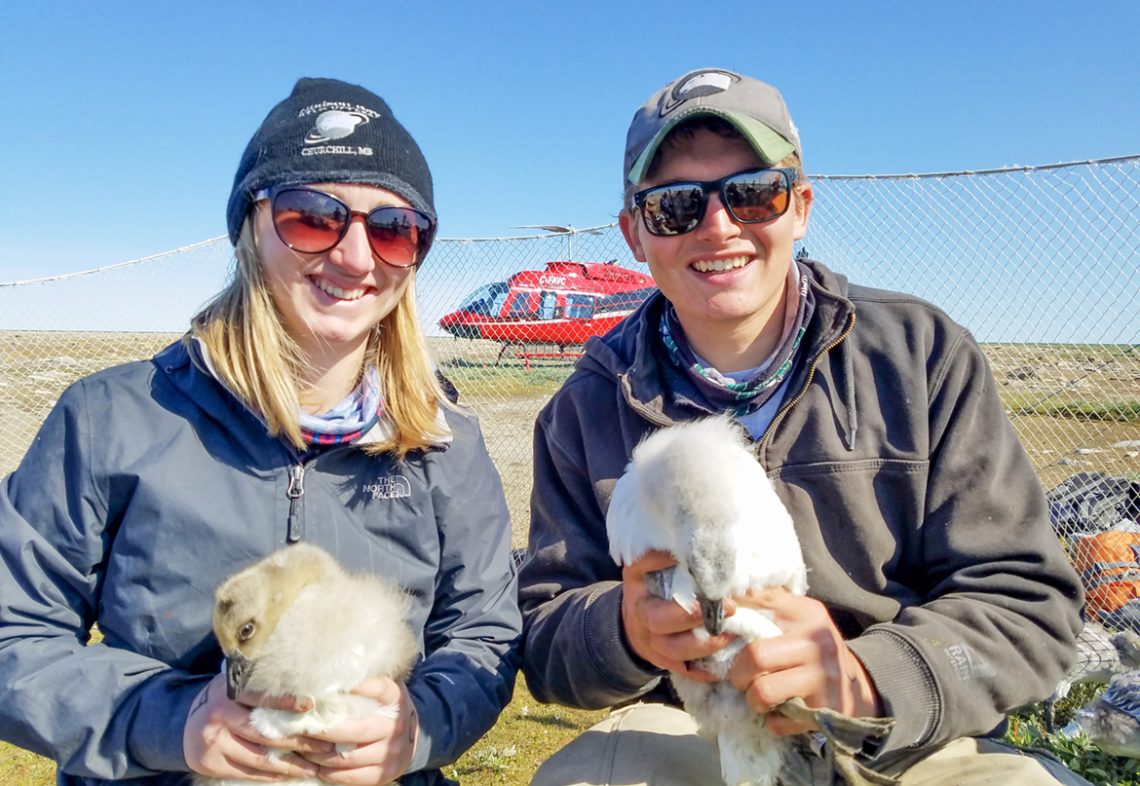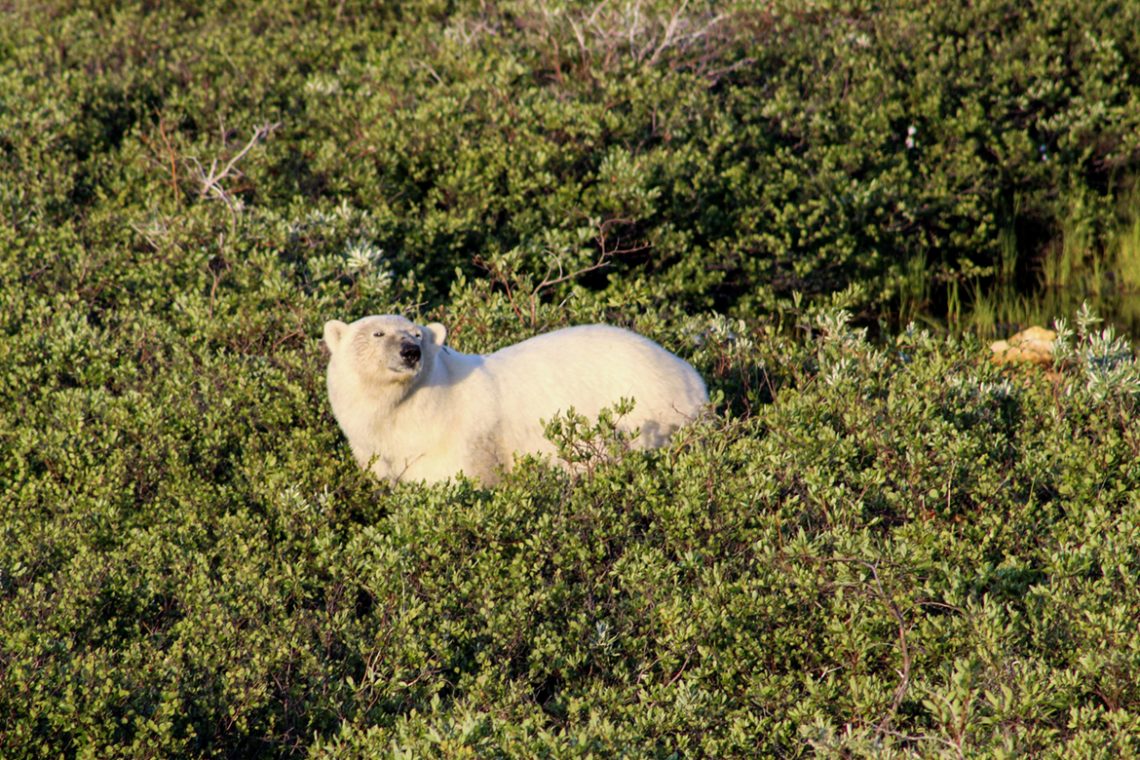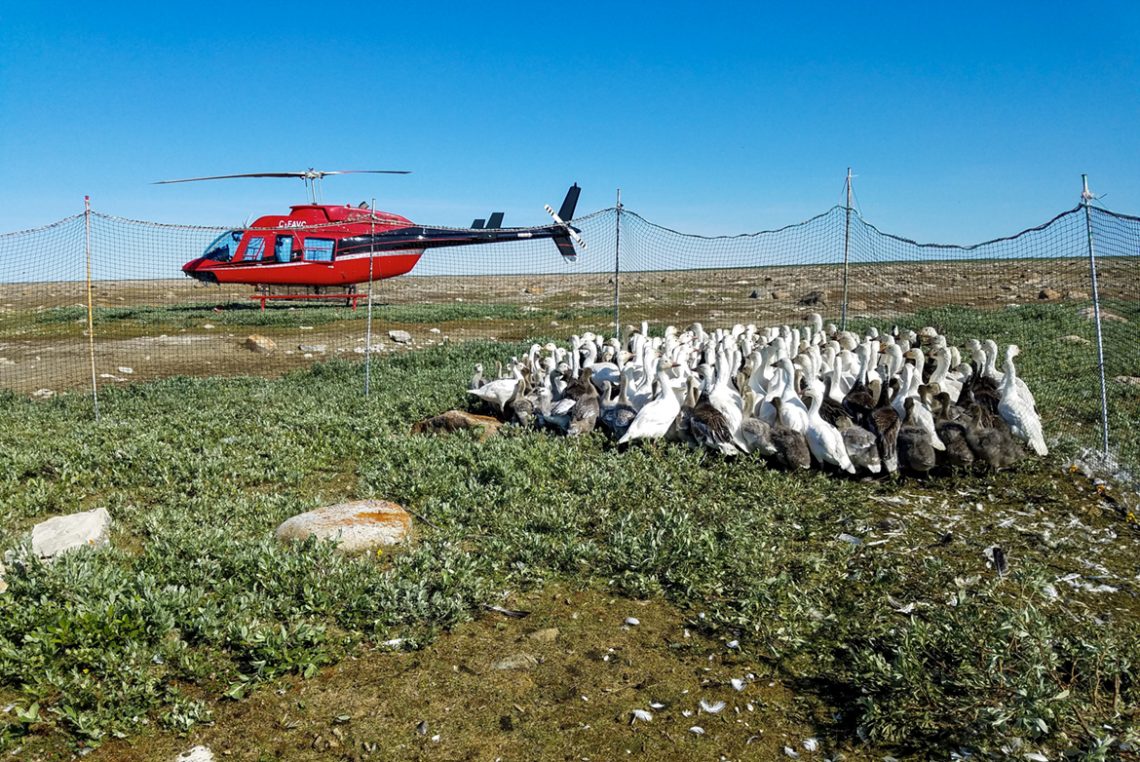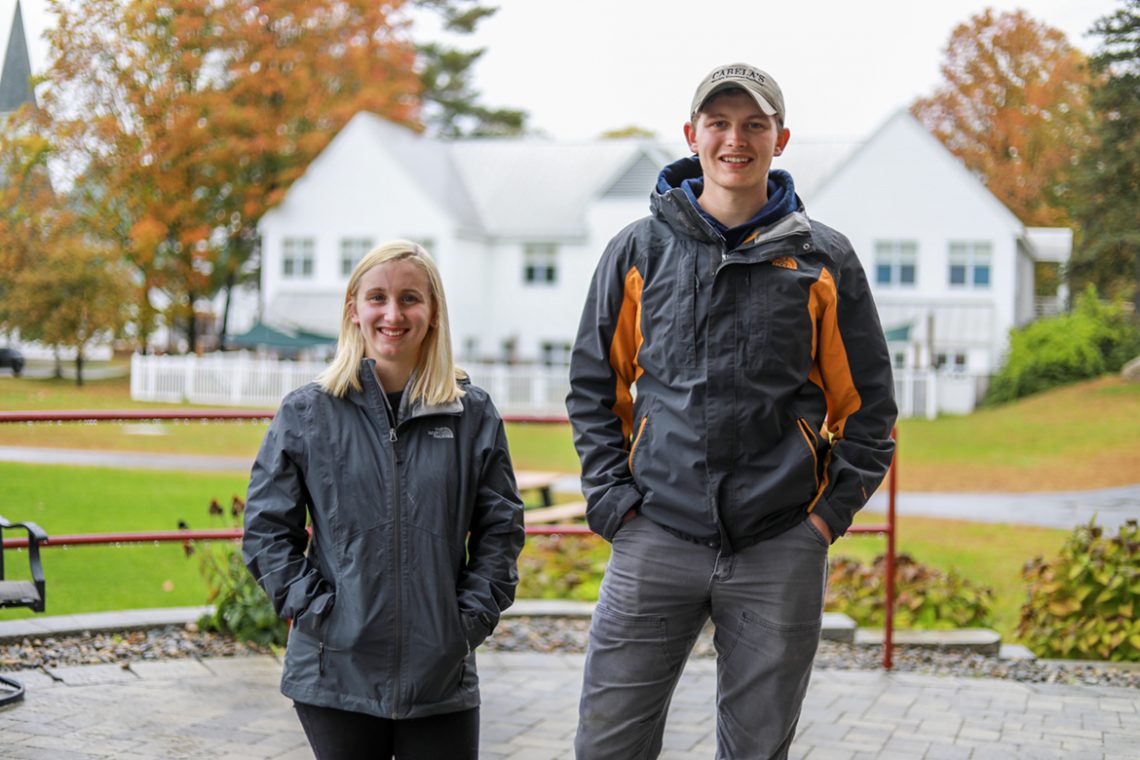Two UMF students spend their summer researching snow geese and polar bears — 68 miles south of the Arctic Circle.
By Ryan Mastrangelo, October 2018
Of the scores of UMF students who conducted internships this past summer, Jessica Howe ’20 and Tom Dolman ’21 may have gone farthest afield from campus — 68 miles south of the Arctic Circle, to be exact.

Jessica Howe ’20 and Tom Dolman ’21 with some of the snow geese they banded as part of research they conducted in the Canadian Province of Manitoba. (Photo courtesy of Jessica Howe ’20 and Tom Dolman ’21.)
At the Hudson Bay Project’s Nestor 2 research camp in the Canadian Province of Manitoba, Howe and Dolman spent summer 2019 investigating the effects of climate change on the region’s snow geese and polar bear populations. The camp itself is on the primary route for polar bears coming off the sea ice for the summer, as well as caribou, beluga whales, and grizzly and brown bears.
So how did the two UMF students from Bethel, Conn., find themselves in subarctic environs of Northern Canada studying snow geese and polar bears? Dolman says it all began in his sophomore year of high school when a friend of his father, Robert “Rocky” Rockwell, professor of biology at City University of New York, was a guest speaker in one of his classes. Dolman says the type of work that Rockwell presented “really stuck” with him and that very summer he found himself volunteering at the Hudson Bay Project, where Rockwell is a lead investigator. A year later, Dolman returned as a paid technician, helping graduate students as a research assistant.
“I was interested in getting experience in the scientific field and this seemed like a great way to get my feet wet, literally,” says Dolman. “I enjoyed my first year so much that when I was offered a position the next year, I was happy to say yes.”
The research being conducted at the Hudson Bay Project examines how changes in weather patterns are affecting the migration behavior of polar bears. Because of climate change, polar ice is melting sooner in the year, forcing polar bears to come off the ice earlier. They are now migrating to summer breeding grounds of a large snow geese population that has been booming over the last 20 years. Thus, the fragile subarctic tundra is hosting 75,000 mating pairs of snow geese and large numbers of polar bears. The foraging behavior of snow geese — how they grub for plants — is destroying the plant life. And the presence of snow geese and polar bear — both at the same time — is a hardship for the habitat.

Howe says this polar bear was approaching the electric cattle fence around the perimeter of the camp when she photographed it from 30 yards away. Hudson Bay Project protocol dictates that when a bear is sighted, everyone must climb onto a cabin rooftop to ensure safety and maintain line of sight on the bear. (Photograph by Jessica Howe ’20.)
Accessible only by helicopter and snowmobile, the Hudson Bay Project camp was under eight feet of snow and ice when Dolman arrived in May, and temperatures barely reached the 30s. By late June, when Howe arrived, the snow had mostly melted and temperatures were in the relatively balmy 50s. The weather may have moderated, but Howe says the threat of encounters with polar bears remained.
Since bear safety is a daily concern, each of the off-grid research camp’s three 16-by-32-foot cabins is equipped with a 12-gauge shotgun, a 2 by 4-foot barricade at the point of egress, and a ladder that’s affixed to the exterior of the cabin for rapid roof access. There is also an electric cattle fence around the entire camp perimeter.
“After Tom’s first season in the tundra, all of the stories made me very interested in the work he experienced and very jealous,” says Howe, who is majoring in early childhood education at UMF. “My field may be education, but my interests in the outdoors and wildlife drew me to pursue this opportunity. Stories do not do justice of what life is really like at camp.”
Howe says she joined the research effort during the “exciting time” of banding week, when as many as a dozen project collaborators travel from all over the country to help put metal identification bands on the legs of some 6,000 snow geese. Her and Dolman’s daily commute, by helicopter, provided stunning views of the subarctic region.
“Dr. Rockwell was in charge of finding the sites by performing helicopter surveys the week prior and checking nesting density with nesting cameras,” explains Howe.

Howe and Dolman commuted by helicopter from camp to banding sites 10 to 15 kilometers away. Here the snow geese have been corralled into a netted area where they can be scooped up by researchers for banding. (Photo courtesy of Jessica Howe ’20 and Tom Dolman ’21.)
Banding days typically involved corralling geese through the coordinated movements of a helicopter and individuals on the ground and driving them into netted areas. The process can take up to nine hours.
“The days were physically tiring, but so rewarding,” says Howe.
Rachel Hovel, assistant professor of biology at UMF, says the research experiences Howe and Dolman had this past summer are “some of the richest time spent in a student’s undergraduate career.”
“Opportunities like these help demystify what it’s like to work in the sciences, and give young researchers a real stake in important projects,” says Hovel. “Students come away with confidence in their skills, a broader network of connections, and both new curiosities and refined interests — all of which translate to success when applying for jobs or graduate programs.”
Back at UMF and supported by a Wilson Scholarship, Dolman is working with Hovel on a project that uses some of the data he helped collect over the summer. And there may be other possible research areas to explore, says Hovel. (She conducts research elsewhere in the Arctic, in the Northwest Territories, and focuses on how climate change is impacting fish species and subsistence fisheries in the lower Mackenzie River.) As conversations continue around common interests and collaborations — conversations that are “much-needed in the science field,” says Dolman — there may be a role for UMF and future UMF students to play in the coming years.

Jessica Howe ’20 and Tom Dolman ’21 say a return trip to the Hudson Bay Project may be in the offing. (Photo by Ryan Mastrangelo.)
In the meantime, Dolman’s project at UMF looks at one particular change in stream habitats — observed increases in fine sediments — and how the change dramatically alters the habitat for aquatic insects and affects which species are present and in what abundance.
Dolman will be developing statistical models to test how different habitat parameters, with particular focus on sediment size, influence the species composition and the abundance of aquatic insects in coastal tundra rivers. All of these factors have implications for the rest of the ecosystem, as aquatic insects play important roles in decomposition and carbon cycling, and are an important food source for both aquatic and terrestrial organisms. The research ties back to the Hudson Bay Project, as some migratory duck species rely on the aquatic insects of the region’s coastal tundra rivers for food.
“The types of questions that Tom investigates in the work that he started with the Hudson Bay project — how changing stream habitat affects organisms and food webs — are widely applied elsewhere and also give him a strong and appealing skillset,” says Hovel.
Looking ahead to summer 2020, Dolman says he hopes to return to the Hudson Bay Project to continue the work he started.
“It is a fantastic opportunity and I plan to go back next summer,” says Dolman. “I hope to continue the research I have been working on and enjoy another summer near the Arctic.”
As for Howe, she’s not sure she will spend summer 2020 with the Hudson Bay Project, but says she would “love to return in the near future.”

